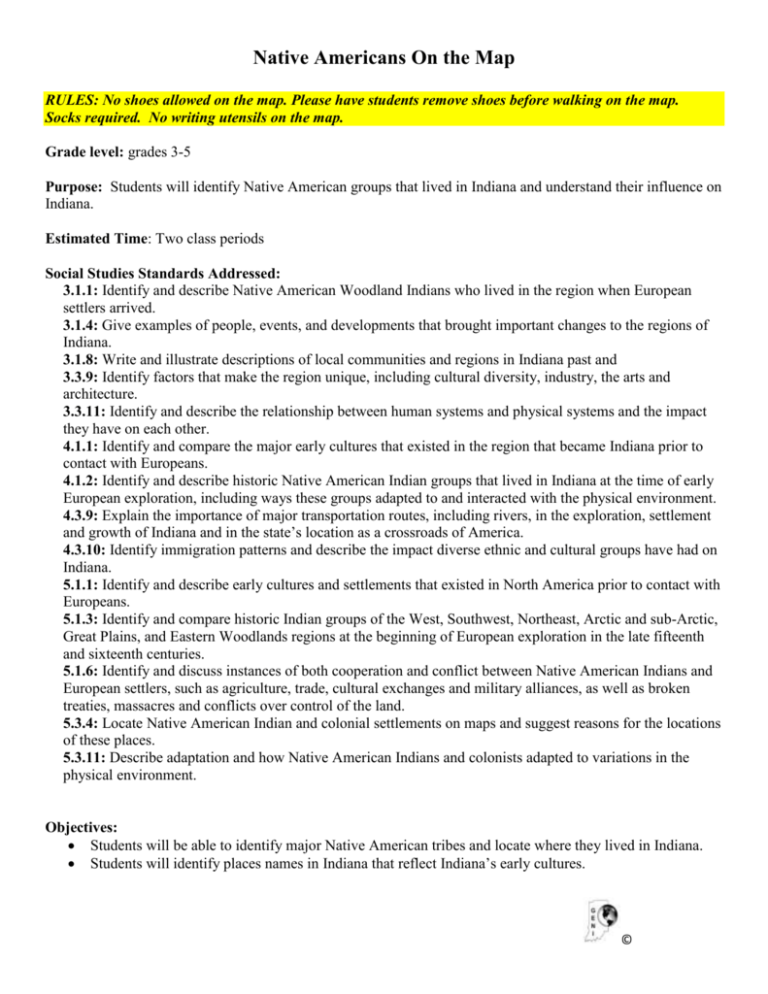Native Americans On the Map
advertisement

Native Americans On the Map RULES: No shoes allowed on the map. Please have students remove shoes before walking on the map. Socks required. No writing utensils on the map. Grade level: grades 3-5 Purpose: Students will identify Native American groups that lived in Indiana and understand their influence on Indiana. Estimated Time: Two class periods Social Studies Standards Addressed: 3.1.1: Identify and describe Native American Woodland Indians who lived in the region when European settlers arrived. 3.1.4: Give examples of people, events, and developments that brought important changes to the regions of Indiana. 3.1.8: Write and illustrate descriptions of local communities and regions in Indiana past and 3.3.9: Identify factors that make the region unique, including cultural diversity, industry, the arts and architecture. 3.3.11: Identify and describe the relationship between human systems and physical systems and the impact they have on each other. 4.1.1: Identify and compare the major early cultures that existed in the region that became Indiana prior to contact with Europeans. 4.1.2: Identify and describe historic Native American Indian groups that lived in Indiana at the time of early European exploration, including ways these groups adapted to and interacted with the physical environment. 4.3.9: Explain the importance of major transportation routes, including rivers, in the exploration, settlement and growth of Indiana and in the state’s location as a crossroads of America. 4.3.10: Identify immigration patterns and describe the impact diverse ethnic and cultural groups have had on Indiana. 5.1.1: Identify and describe early cultures and settlements that existed in North America prior to contact with Europeans. 5.1.3: Identify and compare historic Indian groups of the West, Southwest, Northeast, Arctic and sub-Arctic, Great Plains, and Eastern Woodlands regions at the beginning of European exploration in the late fifteenth and sixteenth centuries. 5.1.6: Identify and discuss instances of both cooperation and conflict between Native American Indians and European settlers, such as agriculture, trade, cultural exchanges and military alliances, as well as broken treaties, massacres and conflicts over control of the land. 5.3.4: Locate Native American Indian and colonial settlements on maps and suggest reasons for the locations of these places. 5.3.11: Describe adaptation and how Native American Indians and colonists adapted to variations in the physical environment. Objectives: Students will be able to identify major Native American tribes and locate where they lived in Indiana. Students will identify places names in Indiana that reflect Indiana’s early cultures. © Students will be able to describe and explain the cultural influence Native Americans had on the naming and development of Indiana and places in the state. Procedures: 1. Explain the rules for using the map of Indiana. 2. Ask students to explain the meaning of the name Indiana (Land of Indians) 3. Have students discuss what they know about Native American groups in Indiana. 4. Give students a strip of paper that has the name of an Indiana Native American group on it. 5. Have students work in teams to research the group that they were assigned. 6. Have the groups identify the region of Indiana that their tribe lived by standing on the map and then place their strip on the map. 7. Have students look at the map to identify places and things on the map that have Native American names.* 8. Discuss what the location of these places says about Indiana’s settlement. 9. Select a Native American group and do a presentation on how they lived and the culture of their community. Additional Activities: Locate other places on a map of Indiana and research the meaning and how each place got its name. Research the meaning of your town and school and find out how they were named. Locate places on an Indiana Map that have foreign names or are named after places in other countries. Assessment: Students will research and give an oral or written presentation that includes a map on a Native American tribe that lived in Indiana. This can be written, oral or as a power point presentation. *List of place names and background is included via the GTM IN Curriculum website ©




